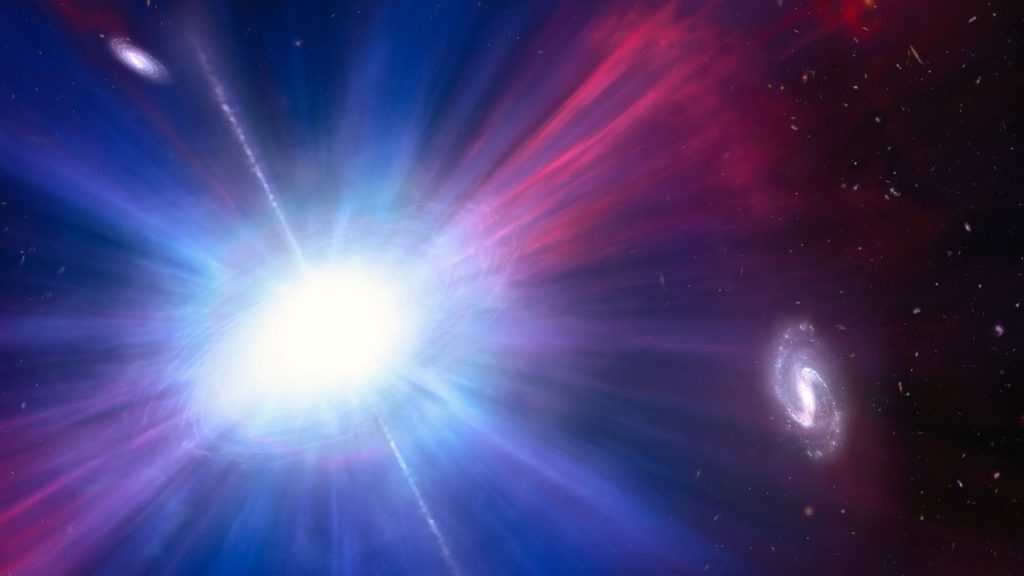The astronomical community is abuzz with excitement over a newly discovered cosmic phenomenon, nicknamed the “Platypus,” due to its unique blend of characteristics from two distinct celestial events. This bright burst of energy, originating from a dwarf galaxy approximately 6.5 billion light-years away, presents a fascinating puzzle that could potentially revolutionize our understanding of supermassive black hole formation. The Platypus exhibits traits reminiscent of both a tidal disruption event (TDE), the dramatic demise of a star torn apart by a black hole’s immense gravity, and a luminous fast blue optical transient (LFBOT), a type of exploding star. This dual nature makes it a prime candidate for bridging the gap between these two enigmatic classes of cosmic flares.
The discovery of the Platypus was serendipitous. A team of astronomers, led by Vikram Ravi of Caltech, was initially searching for tidal disruption events around intermediate-mass black holes, hypothesized to be the precursors of supermassive black holes. Intermediate-mass black holes, with masses thousands of times that of our sun, are thought to be the “seeds” from which supermassive black holes, billions of times more massive, grow. Understanding the nature and behavior of these intermediate-mass black holes is crucial for unraveling the mystery of supermassive black hole formation in the early universe. The team’s search, using the Palomar Observatory near San Diego, led them to a promising flare detected in July.
Subsequent observations with the Hubble Space Telescope revealed the astonishing brightness of this event, emanating from the periphery of a small, distant galaxy. The flare outshone all the stars in its host galaxy by a factor of 100, a level of luminosity rarely observed in such events. This extraordinary brightness immediately suggested two possible explanations: an exceptionally massive star undergoing a dramatic explosion or a supermassive black hole devouring a star. However, the diminutive size of the host galaxy made both scenarios unlikely. Galaxies of this scale typically lack the massive stars capable of such extreme explosions, and the presence of a supermassive black hole is also improbable. This led the team to consider an intermediate-mass black hole as the most likely culprit, potentially providing strong evidence for their existence and role in the evolution of supermassive black holes.
The Platypus further intrigued astronomers by exhibiting characteristics of an LFBOT. LFBOTs are known for their intense blue light and rapid increase in brightness. The Platypus displayed both these features, initially suggesting it might belong to this category. However, unlike typical LFBOTs, whose brightness peaks and declines within a few days, the Platypus maintained its intense glow for two weeks, a timescale more characteristic of a tidal disruption event. This prolonged luminosity adds another layer of complexity to the Platypus, blurring the lines between TDEs and LFBOTs.
The dual nature of the Platypus offers a tantalizing possibility: it could represent a missing link between these two distinct phenomena. Perhaps the Platypus represents a unique scenario where a star is disrupted by an intermediate-mass black hole, leading to an event that shares characteristics of both TDEs and LFBOTs. This could provide a new pathway for understanding the evolution of black holes and the diverse range of cosmic explosions. Furthermore, the Platypus’s location in a dwarf galaxy suggests that intermediate-mass black holes might be more common in these smaller galactic environments than previously thought, potentially playing a significant role in their evolution.
To further investigate the nature of this intriguing object, astronomers plan to utilize the combined power of the Hubble and James Webb Space Telescopes in the coming months. Simultaneous observations from these powerful instruments could provide crucial data to discern the Platypus’s true origins and the mechanisms driving its unusual behavior. The upcoming Vera Rubin Observatory in Chile, with its unprecedented sky-surveying capabilities, is expected to discover hundreds more Platypus-like events, if they exist, allowing astronomers to statistically analyze these phenomena and refine their understanding. This could open up a new era in the study of cosmic explosions and the evolution of black holes, providing invaluable insights into the dynamic processes shaping our universe.
The discovery of the Platypus is a testament to the ongoing quest to unravel the mysteries of the cosmos. This unique celestial event challenges our current understanding of stellar explosions and black hole evolution, highlighting the importance of continuous observation and the potential for unexpected discoveries. The Platypus symbolizes the ever-evolving nature of our knowledge about the universe and the exciting possibilities that lie ahead as we continue to explore the vast expanse of space. The future of astronomical research promises to be filled with such intriguing puzzles, pushing the boundaries of our understanding and revealing the awe-inspiring complexity of the universe we inhabit.


